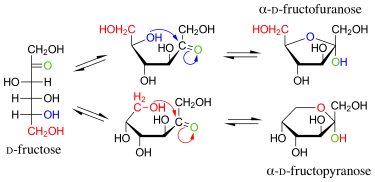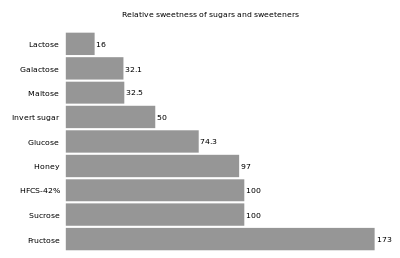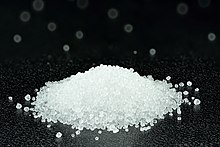
A | B | C | D | E | F | G | H | CH | I | J | K | L | M | N | O | P | Q | R | S | T | U | V | W | X | Y | Z | 0 | 1 | 2 | 3 | 4 | 5 | 6 | 7 | 8 | 9
This article's lead section contains information that is not included elsewhere in the article. (March 2023) |
| |||
 Haworth projection of β-d-fructofuranose
| |||
| |||
| Names | |||
|---|---|---|---|
| IUPAC name
D-arabino-Hex-2-ulose[3]
| |||
| Systematic IUPAC name
(3S,4R,5R)-1,3,4,5,6-Pentahydroxyhexan-2-one | |||
| Other names | |||
| Identifiers | |||
3D model (JSmol)
|
|||
| ChEBI | |||
| ChEMBL | |||
| ChemSpider | |||
| ECHA InfoCard | 100.000.303 | ||
| EC Number |
| ||
| KEGG | |||
PubChem CID
|
|||
| UNII | |||
CompTox Dashboard (EPA)
|
|||
| |||
| |||
| Properties | |||
| C6H12O6 | |||
| Molar mass | 180.156 g·mol−1 | ||
| Density | 1.694 g/cm3 | ||
| Melting point | 103 °C (217 °F; 376 K) | ||
| ~4000 g/L (25 °C) | |||
| −102.60×10−6 cm3/mol | |||
| Thermochemistry | |||
Std enthalpy of
combustion (ΔcH⦵298) |
675.6 kcal/mol (2,827 kJ/mol)[4] (Higher heating value) | ||
| Pharmacology | |||
| V06DC02 (WHO) | |||
| Hazards | |||
| Lethal dose or concentration (LD, LC): | |||
LD50 (median dose)
|
15000 mg/kg (intravenous, rabbit)[5] | ||
Except where otherwise noted, data are given for materials in their standard state (at 25 °C , 100 kPa).
| |||
Fructose (/ˈfrʌktoʊs, -oʊz/), or fruit sugar, is a ketonic simple sugar found in many plants, where it is often bonded to glucose to form the disaccharide sucrose. It is one of the three dietary monosaccharides, along with glucose and galactose, that are absorbed by the gut directly into the blood of the portal vein during digestion. The liver then converts both fructose and galactose into glucose, so that dissolved glucose, known as blood sugar, is the only monosaccharide present in circulating blood.
Fructose was discovered by French chemist Augustin-Pierre Dubrunfaut in 1847.[6][7] The name "fructose" was coined in 1857 by the English chemist William Allen Miller.[8] Pure, dry fructose is a sweet, white, odorless, crystalline solid, and is the most water-soluble of all the sugars.[9] Fructose is found in honey, tree and vine fruits, flowers, berries, and most root vegetables.
Commercially, fructose is derived from sugar cane, sugar beets, and maize. High-fructose corn syrup is a mixture of glucose and fructose as monosaccharides. Sucrose is a compound with one molecule of glucose covalently linked to one molecule of fructose. All forms of fructose, including those found in fruits and juices, are commonly added to foods and drinks for palatability and taste enhancement, and for browning of some foods, such as baked goods. As of 2004, about 240,000 tonnes of crystalline fructose were being produced annually.[10]
Excessive consumption of sugars, including fructose, (especially from sugar-sweetened beverages) may contribute to insulin resistance, obesity, elevated LDL cholesterol and triglycerides, leading to metabolic syndrome. The European Food Safety Authority (EFSA) stated in 2011 that fructose may be preferable over sucrose and glucose in sugar-sweetened foods and beverages because of its lower effect on postprandial blood sugar levels,[11] while also noting the potential downside that "high intakes of fructose may lead to metabolic complications such as dyslipidaemia, insulin resistance, and increased visceral adiposity".[11][12] The UK's Scientific Advisory Committee on Nutrition in 2015 disputed the claims of fructose causing metabolic disorders, stating that "there is insufficient evidence to demonstrate that fructose intake, at levels consumed in the normal UK diet, leads to adverse health outcomes independent of any effects related to its presence as a component of total and free sugars."[13]
Etymology
The word "fructose" was coined in 1857 from the Latin for fructus (fruit) and the generic chemical suffix for sugars, -ose.[8][14] It is also called fruit sugar and levulose or laevulose, due to its ability to rotate plane polarised light in a laevorotary fashion (anti-clockwise/to the left) when a beam is shone through it in solution. Likewise, dextrose (an isomer of glucose) is given its name due to its ability to rotate plane polarised light in a dextrorotary fashion (clockwise/to the right).[14]
Chemical properties


Fructose is a 6-carbon polyhydroxyketone.[15] Crystalline fructose adopts a cyclic six-membered structure, called β-d-fructopyranose, owing to the stability of its hemiketal and internal hydrogen-bonding. In solution, fructose exists as an equilibrium mixture of the tautomers β-d-fructopyranose, β-d-fructofuranose, α-d-fructofuranose, α-d-fructopyranose and keto-d-fructose (the non-cyclic form).[16]
The distribution of d-fructose tautomers in solution is related to several variables, such as solvent and temperature.[17] d-Fructopyranose and d-fructofuranose distributions in water have been identified multiple times as roughly 70% fructopyranose and 22% fructofuranose.[18]
Reactions
Fructose and fermentation
Fructose may be anaerobically fermented by yeast and bacteria.[19] Yeast enzymes convert sugar (sucrose, glucose, and fructose, but not lactose) to ethanol and carbon dioxide.[20] Some of the carbon dioxide produced during fermentation will remain dissolved in water, where it will reach equilibrium with carbonic acid. The dissolved carbon dioxide and carbonic acid produce the carbonation in some fermented beverages, such as champagne.
Fructose and Maillard reaction
Fructose undergoes the Maillard reaction, non-enzymatic browning, with amino acids. Because fructose exists to a greater extent in the open-chain form than does glucose, the initial stages of the Maillard reaction occur more rapidly than with glucose. Therefore, fructose has potential to contribute to changes in food palatability, as well as other nutritional effects, such as excessive browning, volume and tenderness reduction during cake preparation, and formation of mutagenic compounds.[21]
Dehydration
Fructose readily dehydrates to give hydroxymethylfurfural ("HMF", C
6H
6O
3), which can be processed into liquid dimethylfuran (C
6H
8O).
This process, in the future, may become part of a low-cost, carbon-neutral system to produce replacements for petrol and diesel from plants.[22]
Physical and functional properties
Sweetness of fructose
The primary reason that fructose is used commercially in foods and beverages, besides its low cost, is its high relative sweetness. It is the sweetest of all naturally occurring carbohydrates. The relative sweetness of fructose has been reported in the range of 1.2–1.8 times that of sucrose.[23][24][25][26] However, it is the 6-membered ring form of fructose that is sweeter; the 5-membered ring form tastes about the same as usual table sugar. Warming fructose leads to formation of the 5-membered ring form.[27] Therefore, the relative sweetness decreases with increasing temperature. However, it has been observed that the absolute sweetness of fructose is identical at 5 °C as 50 °C and thus the relative sweetness to sucrose is not due to anomeric distribution but a decrease in the absolute sweetness of sucrose at higher temperatures.[25]

The sweetness of fructose is perceived earlier than that of sucrose or glucose, and the taste sensation reaches a peak (higher than that of sucrose), and diminishes more quickly than that of sucrose. Fructose can also enhance other flavors in the system.[23][25]
Fructose exhibits a sweetness synergy effect when used in combination with other sweeteners. The relative sweetness of fructose blended with sucrose, aspartame, or saccharin is perceived to be greater than the sweetness calculated from individual components.[28][25]
Fructose solubility and crystallization
Fructose has higher water solubility than other sugars, as well as other sugar alcohols. Fructose is, therefore, difficult to crystallize from an aqueous solution.[23] Sugar mixes containing fructose, such as candies, are softer than those containing other sugars because of the greater solubility of fructose.[29]
Fructose hygroscopicity and humectancy
Fructose is quicker to absorb moisture and slower to release it to the environment than sucrose, glucose, or other nutritive sweeteners.[28] Fructose is an excellent humectant and retains moisture for a long period of time even at low relative humidity (RH). Therefore, fructose can contribute a more palatable texture, and longer shelf life to the food products in which it is used.[23]
Freezing point
Fructose has a greater effect on freezing point depression than disaccharides or oligosaccharides, which may protect the integrity of cell walls of fruit by reducing ice crystal formation. However, this characteristic may be undesirable in soft-serve or hard-frozen dairy desserts.[23]
Fructose and starch functionality in food systems
Fructose increases starch viscosity more rapidly and achieves a higher final viscosity than sucrose because fructose lowers the temperature required during gelatinizing of starch, causing a greater final viscosity.[30]
Although some artificial sweeteners are not suitable for home baking, many traditional recipes use fructose.[31]
Food sources
This section needs additional citations for verification. (December 2017) |

Natural sources of fructose include fruits, vegetables (including sugar cane), and honey.[32] Fructose is often further concentrated from these sources. The highest dietary sources of fructose, besides pure crystalline fructose, are foods containing white sugar (sucrose), high-fructose corn syrup, agave nectar, honey, molasses, maple syrup, fruit and fruit juices, as these have the highest percentages of fructose (including fructose in sucrose) per serving compared to other common foods and ingredients. Fructose exists in foods either as a free monosaccharide or bound to glucose as sucrose, a disaccharide. Fructose, glucose, and sucrose may all be present in food; however, different foods will have varying levels of each of these three sugars.
The sugar contents of common fruits and vegetables are presented in Table 1. In general, in foods that contain free fructose, the ratio of fructose to glucose is approximately 1:1; that is, foods with fructose usually contain about an equal amount of free glucose. A value that is above 1 indicates a higher proportion of fructose to glucose and below 1 a lower proportion. Some fruits have larger proportions of fructose to glucose compared to others. For example, apples and pears contain more than twice as much free fructose as glucose, while for apricots the proportion is less than half as much fructose as glucose.
Apple and pear juices are of particular interest to pediatricians because the high concentrations of free fructose in these juices can cause diarrhea in children. The cells (enterocytes) that line children's small intestines have less affinity for fructose absorption than for glucose and sucrose.[33] Unabsorbed fructose creates higher osmolarity in the small intestine, which draws water into the gastrointestinal tract, resulting in osmotic diarrhea. This phenomenon is discussed in greater detail in the Health Effects section.
Table 1 also shows the amount of sucrose found in common fruits and vegetables. Sugarcane and sugar beet have a high concentration of sucrose, and are used for commercial preparation of pure sucrose. Extracted cane or beet juice is clarified, removing impurities; and concentrated by removing excess water. The end product is 99.9%-pure sucrose. Sucrose-containing sugars include common white sugar and powdered sugar, as well as brown sugar.[34]
| Food Item | Total carbohydrateA including "dietary fiber" |
Total sugars |
Free fructose |
Free glucose |
Sucrose | Fructose/ glucose ratio |
Sucrose as a % of total sugars |
Free fructose as a % of total sugars |
|---|---|---|---|---|---|---|---|---|
| Fruits | ||||||||
| Apple | 13.8 | 10.4 | 5.9 | 2.4 | 2.1 | 2.0? | 19.9 | 57 |
| Apricot | 11.1 | 9.2 | 0.9 | 2.4 | 5.9 | 0.7? | 63.5 | 10 |
| Banana | 22.8 | 12.2 | 4.9 | 5.0 | 2.4 | 1.0 | 20.0 | 40 |
| Fig, dried | 63.9 | 47.9 | 22.9 | 24.8 | 0.9? | 0.93 | 1.9 | 47.8 |
| Grapes | 18.1 | 15.5 | 8.1 | 7.2 | 0.2 | 1.1 | 1 | 52 |
| Navel orange | 12.5 | 8.5 | 2.25 | 2.0 | 4.3 | 1.1 | 50.4 | 26 |
| Peach | 9.5 | 8.4 | 1.5 | 2.0 | 4.8 | 0.9? | 56.7 | 18 |
| Pear | 15.5 | 9.8 | 6.2 | 2.8 | 0.8 | 2.1? | 8.0 | 63 |
| Pineapple | 13.1 | 9.9 | 2.1 | 1.7 | 6.0 | 1.1 | 60.8 | 21 |
| Plum | 11.4 | 9.9 | 3.1 | 5.1 | 1.6 | 0.66 | 16.2 | 31 |
| Vegetables | ||||||||
| Beet, Red | 9.6 | 6.8 | 0.1 | 0.1 | 6.5 | 1.0 | 96.2 | 1.5 |
| Carrot | 9.6 | 4.7 | 0.6 | 0.6 | 3.6 | 1.0 | 77 | 13 |
| Red Pepper, Sweet | 6.0 | 4.2 | 2.3 | 1.9 | 0.0 | 1.2 | 0.0 | 55 |
| Onion, Sweet | 7.6 | 5.0 | 2.0 | 2.3 | 0.7 | 0.9 | 14.3 | 40 |
| Sweet Potato | 20.1 | 4.2 | 0.7 | 1.0 | 2.5 | 0.9 | 60.3 | 17 |
| Yam | 27.9 | 0.5 | tr | tr | tr | na | tr | |
| Sugar Cane | 13–18 | 0.2 – 1.0 | 0.2 – 1.0 | 11–16 | 1.0 | high | 1.5-5.6 | |
| Sugar Beet | 17–18 | 0.1 – 0.5 | 0.1 – 0.5 | 16–17 | 1.0 | high | 0.59-2.8 | |
| Grains | ||||||||
| Maize, Sweet | 19.0 | 6.2 | 1.9 | 3.4 | 0.9 | 0.61 | 15.0 | 31 |
- ^A The carbohydrate figure is calculated in FoodData Central and does not always correspond to the sum of the sugars, the starch, and the "dietary fiber".
All data with a unit of g (gram) are based on 100 g of a food item.
The fructose/glucose ratio is calculated by dividing the sum of free fructose plus half sucrose by the sum of free glucose plus half sucrose.
Zdroj:https://en.wikipedia.org?pojem=Fructose
Text je dostupný za podmienok Creative Commons Attribution/Share-Alike License 3.0 Unported; prípadne za ďalších podmienok. Podrobnejšie informácie nájdete na stránke Podmienky použitia.
Antropológia
Aplikované vedy
Bibliometria
Dejiny vedy
Encyklopédie
Filozofia vedy
Forenzné vedy
Humanitné vedy
Knižničná veda
Kryogenika
Kryptológia
Kulturológia
Literárna veda
Medzidisciplinárne oblasti
Metódy kvantitatívnej analýzy
Metavedy
Metodika
Text je dostupný za podmienok Creative
Commons Attribution/Share-Alike License 3.0 Unported; prípadne za ďalších
podmienok.
Podrobnejšie informácie nájdete na stránke Podmienky
použitia.
www.astronomia.sk | www.biologia.sk | www.botanika.sk | www.dejiny.sk | www.economy.sk | www.elektrotechnika.sk | www.estetika.sk | www.farmakologia.sk | www.filozofia.sk | Fyzika | www.futurologia.sk | www.genetika.sk | www.chemia.sk | www.lingvistika.sk | www.politologia.sk | www.psychologia.sk | www.sexuologia.sk | www.sociologia.sk | www.veda.sk I www.zoologia.sk




